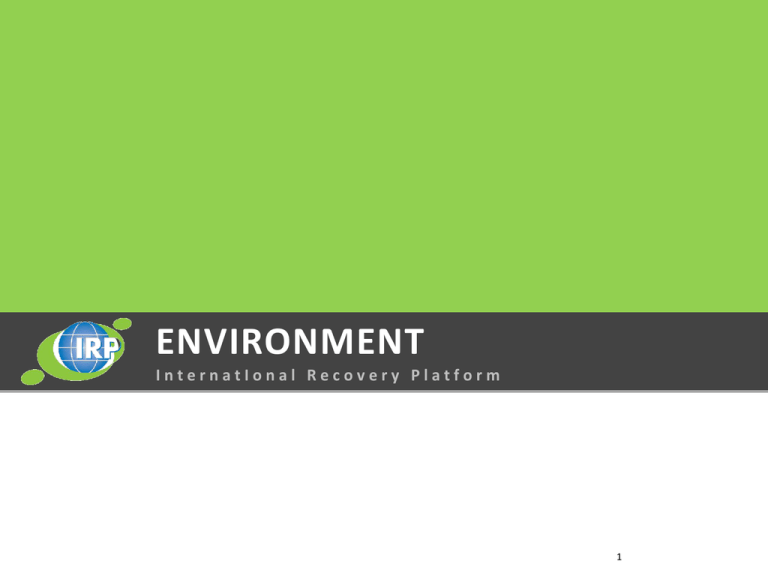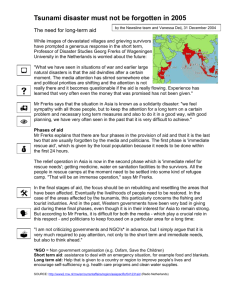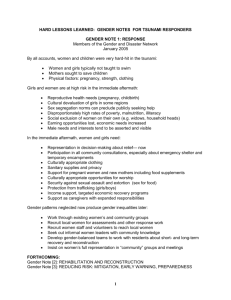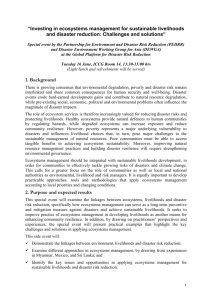ENVIRONMENT
advertisement

ENVIRONMENT InternatIonal Recovery Platform 1 TODAY`S AGENDA 1. Introduction 2. Introduction to Key Issues Issue 1: Dealing with disaster debris Potential environmental and health impacts of waste management activities Challenges of managing post disaster waste Managing hazardous wastes Recycling disaster waste Creating employment opportunities Issue 2: Implementing environmentally sound reconstruction Site selection Local procurement of building materials Alternative building materials and technologies Strategic environmental and social framework 2 TODAY`S AGENDA Issue 3: Promoting environmentally sustainable livelihoods Environmental impacts of livelihood recovery efforts Learning from indigenous practices Adapting improved livelihood practices Diversifying livelihoods to reduce pressures on the environment Developing alternative livelihoods Integrated management of ecosystems Issue 4: Rehabilitating ecosystems Creating protected areas Protecting ecosystems through eco-tourism Awareness-raising 3 1. Humans rely on the productive services of ecosystems to sustain life and livelihoods. Poor and marginalized people often are more directly dependent on ecosystem services. 2. Environmental degradation diminishes an ecosystem’s capacity to provide resources critical to human life and livelihoods. 3. Environmental degradation leads to an increase in the frequency and intensity of natural disasters, and exacerbates the impacts of such disasters. 4. Natural disasters weaken already strained ecosystems. Examples: Sand dunes in Tamil Nadu, Haiti, Mississippi delta 4 INTRODUCTION Why Consider Environment in Recovery DEALING WITH DISASTER DEBRIS 5 Disaster debris may include waste soils and sediments, vegetation (trees, limbs, shrubs), municipal solid waste (common household garbage, personal belongings), construction and demolition debris (building and their contents), vehicles (cars, trucks, boats), and white goods (refrigerators, freezers, air conditioners). The often vast amount of waste, not only impedes access to affected areas, but can propagate dangerous infectious diseases. Moreover, damage to industrial facilities, refineries, and sewer systems, can trigger secondary hazards. It can contaminate ground water 6 DEALING WITH DISASTER DEBRIS Issue 1: Dealing with disaster debris Sub Issue 2 : Challenges of managing post disaster waste • There may be no formalized waste management system. • Environmental standards may not be integrated into waste management processes. • Clearing and processing of wastes are not systematized, and done on an ad-hoc manner, losing opportunities for recycling/reusing the wastes, and creating jobs/income for affected populations. • Overburdened pre-existing facilities often do not have access to the large machinery required to demolish and remove largescale debris or the trucks to transport it. • Most international humanitarian actors have little technical experience in waste management. 7 Case 1 : Coordination challenges and environmental impacts of post disaster waste management in Turkey – 1999 Earthquake 13 MILLION TONNES 1.A Crisis Center (CC) was quickly established within the Ministry of Environment to assist overwhelmed municipalities manage the waste. 2.Technical specialists were sent by the CC in order to help local staff determine sites for the disposal of demolition waste. 3. The waste was used as engineering land fill for the construction of new villages and for protection occasional flooding of the river. Lessons Municipalities need technical support to manage the huge quantities of waste generated from a disaster Capacity analysis key to finding solutions (public/private sector trucks) MoE identified 17 sites but municipality forces to use more, uncontrolled and challenged logistics 8 Sub Issue 3: Managing hazardous wastes The most urgent waste concern is locating, containing and safely managing hazardous substances. Efforts to identify and control hazardous wastes commonly takes place during the emergency or relief phase, however exposure to hazardous substances can occur throughout recovery phase. One example is the exposure and inhalation of asbestos from damaged buildings which can cause serious respiratory illnesses, including lung cancer. Case 2: Chemical spills during the Great Hanshin earthquake in Japan 1.According to the study, 55 of the 377 researched sites where were found to have contaminated soil. 2.In the worst case, the tetra-chloro-ethylene concentration reached 3,900 times more than the environmental quality standards. 3.In many cases reconstruction works were already underway, leaving the contaminated soil as it was – Know first, plan first. 9 UNEP Guidelines on managing hazardous substances • • • • • Access to affected sites should be restricted until clean-up can be under taken. Appropriate Personal Protective Equipment (PPE) should be used at all times by those individuals involved in assessment and clean-up activities. Plan the location of emergency waste disposal sites with local authorities to avoid potential contamination of water sources and the generation of disease vectors and odors. The burning of waste should, as far as is possible, be avoided due to the risk of inhalation of toxic fumes by residents and workers, particularly where plastics are being burned. Where burning is being considered a thorough risk assessment should be undertaken Where appropriate facilities are not locally available for the disposal of hazardous waste, such as chemicals and hydrocarbons, temporary storage facilities should be constructed and used until such time as appropriate long-term disposal solutions are identified. 10 Sub Issue 4: Recycling disaster waste There is a significant range of uses for recycled waste materials 90% of demolition waste is recyclable if contaminants have been removed and the waste sorted. Options • • • • Environmental benefits of recycling Financial benefits of recycling Sorting waste Recycling waste on site 11 Recycling waste on site: Case 4: Homeowners salvage and sell debris in Pakistan • The MCM engaged homeowners in identifying, salvaging and recycling materials that they deemed valuable – through middle-men. •An estimated 20% of a demolished house was returned to the owner for reuse. • Homeowners reported that the money from rebar sales was used to start building a new house, pay off debts accumulated during the months since the earthquake, or help with continuing expenses. • Of the 80% collected, a large part of the rubble was recycled and reused for building blocks and other building materials. Lessons By salvaging and recycling valuable building materials, homeowners were able to earn additional income to begin reconstructing their homes. Recycling debris saves builders from further exploiting the environment to extract needed building materials. In the case of Pakistan, the extraction of building materials had caused past landslides in the region. 12 Sub Issue 5 : Creating employment opportunities Labor intensive employment schemes have not only facilitated the cleanup process, but have provided individuals with much-needed incomes. Case 5: Creating livelihood opportunities in Aceh and Nias through a waste management programme the Tsunami Recovery Waste Management Programme (TRWMP) Temporary workers have been allowed to share revenues derived from the sale of immediately useful materials (metals and plastics). This has provided an additional incentive over and above the Cash for Work wages. Materials not immediately salable (wood, stone, and concrete) have been used to assist small businesses to recover from the tsunami (e.g. provision of timber to brick kilns) or been provided to NGOs to support reconstruction efforts. A furniture workshop with 40 workers has been promoted, which reuses the waste timber to make school furniture. Lessons The extensive work of clearing debris has increasingly served as an opportunity to provide temporary employment to affected populations. Cash-for-work programs - individuals are paid to clear debris. A large extent of disaster debris can often be reused. In addition to the utility of recycled or salvaged materials for housing and public infrastructure projects, disaster debris, such as wood and metal can serve as raw material to help reestablish the businesses of skilled trades-people. Should be designed prior to the disaster 13 ENVIRONMENTALLY SOUND RECONSTRUCTION 14 Issue 2: Implementing environmentally sound reconstruction Site selection Local procurement of building materials Alternative building materials and technologies Strategic environmental and social framework Sub Issue 1 : Site selection In the rush to provide transitional shelter to the thousands of homeless of Sri Lanka and southern India following the 2004 tsunami, authorities chose low-lying sites that later flooded during the monsoons In Indonesia, permanent housing settlements were developed in flood plains and barricaded from the ocean by a sea wall that blocked the surface flow of water and regularly flooded the entire settlement In the post-disaster setting the urgency to rebuild compounds the challenge of choosing appropriate sites. 15 Case 6: Fast track environmental assessment tool in Aceh 1.The Indonesian Environment Ministry agreed to the fast-track assessment method. 2.The fast-track method cut the assessment time in half. When all the formalities had been dealt with, SLGSR workers and the environmental authority organized a public consultation with the nearby village community with nearly 300 people attending, to ensure public agreement before developing the waste site. Lessons It took two years from the day the decision was made to develop a fast-track environmental impact assessment. By then, reconstruction work in Aceh had already progressed so far that the new method was only of use for some of the projects. Identifying or developing such a tool prior to a disaster, can expedite environmental assessments; speeding up recovery efforts while protecting important ecosystems 16 Sub Issue 2: Local procurement of building materials Local sourcing of reconstruction materials immediately creates jobs and injects cash into disrupted economies. Local materials can be acquired quickly and cheaply, without the logistic and administrative challenges that come with importing large amounts of goods. However, these benefits, combined with the urgency to begin rebuilding, commonly overshadow the damaging consequences of massive resource extraction. Case 7: Raw material extraction for post tsunami reconstruction in Indonesia In order to reduce illegal deforestation, many turned to alternative means - through the import of timber (higher costs), import of pre-fabricated houses (higher costs and locally unacceptable designs), new housing designs that specified reduced usage of timber products. •Where extensive amount of damage has occurred, determining appropriate procurement methods will necessitate trade-offs with respect to time, cost, environmental impact, and social feasibility. •Innovative alternatives in building design and building materials design can reduce the overall environmental impact. An ADB report noted that a combination of timber and brick or the use of hollow concrete blocks could greatly reduce the amount of timber required. 17 Sub Issue 3: Alternative building materials and technologies 1. The use of recycled materials or non-traditional, yet abundant natural resources (e.g. bamboo) 2. The development of environmentally-friendly methods to produce building materials (e.g. improved brick kiln designs) 3. The adaptation of designs that minimize environmental damage (e.g. solargenerated electricity, communal sanitation systems) Case 8: Rebuilding to scale with 'eco-materials' in Cuba •CIDEM developed a product (CP40) made with recycled wastes from the sugar industry. •CIDEM provides training and support. •The municipalities co-operate with local banks to finance house owners willing to repair using materials from these local workshops. Lessons • • • Materials are produced locally - diminishes transportation costs Recycling of hazardous waste materials presents a viable alternative. Management of the projects by local governments can ensure that environmental benefits extend beyond the disaster reconstruction phase and become integrated in development planning 18 Sub Issue 4: Strategic environmental and social framework Following the 2004 tsunami, the Indonesian government developed the Strategic Environmental Framework (SEF) whose objectives included supporting environmentally sound investments; ensuring that environmental aspects, are considered at an early stage in the reconstruction planning process. The SEF is designed to assist decisionmaking in the project cycle’s early stages and to provide a practical tool for mitigating project impacts. Similar frameworks have been created in India following the 2004 tsunami, in China following the 2008 Wenchuan earthquake and in Haiti after the 2010 earthquake: Environmental and Social Management Framework- Indian state governments of Pondicherry and Tamil Nadu http://www.pon.nic.in/tsunami/esmf.pdf Environmental and Social Safeguards Screening and Assessment Framework (ESSAF)-Government of China www.sc.gov.cn/zwgk/gggs/js/200912/P020091208339336834603.doc 19 ENVIRONMENTALLY SUSTAINABLE LIVELIHOODS 20 Sub Issue 1: Environmental impacts of livelihood recovery efforts When environmental considerations are not integrated in livelihood programming, the interdependence of ecosystems and livelihoods is frequently overlooked. Case 9: Environmental and economic impacts of fishing boat replacement in Sri Lanka 1. There was an excess of small boats distributed ad hoc by well-wishers, small NGOs and other donors 2. The ready availability of small boats has resulted in new people turning to fisheries as a livelihood in an already overcrowded coastal fishing industry 3. By failing to consider the environmental impacts of the initiatives (i.e. the status of fish populations), this wholesale provision of fishing boats, intended to boost the economic recovery of coastal settlements, has created longer term economic instability. 4. The poorly informed provision of fishing boats occurred in many of the 2004 tsunami affected countries. However, in a minority of cases, the replacement of lost boats was done in close collaboration with fishing communities as well as fishermen’s cooperatives and associations. In these situations, there were fewer reports of overfishing. This is attributed to the role of the fishermen in determining the number and type of boats to be replaced. 21 Sub Issue 2: Learning from indigenous practices Many societies have built up, through hundreds of years of experience and intimate contact with the environment, a body of knowledge - In the design of livelihood programming, building upon indigenous skills and knowledge increases sustainability of the initiative. Case 10: Indigenous flood mitigation in Assam • • • Planting bamboo helps to protect the bunds from being breached and along fish ponds and paddy fields prevents soil erosion. Reduction in maintenance costs. The bamboo grown within a period of 5 years is also used as material for construction, crafts making and paper making. These activities provide additional employment to the community. ERRA in Pakistan Lessons Indigenous practices are most often based on sound principles developed through the interaction between humans and nature over centuries. By beginning with such practices, effective measures can be identified and modified that build upon generations of people’s own experience with their environment. This improves the likelihood of social acceptance, replication, and sustainability 22 Sub Issue 4: Diversifying livelihoods to reduce pressures on the environment Livelihood diversification has been observed to reverse environmental degradation while also providing populations with a “buffer”, when natural events adversely impact an ecosystem’s productivity. Case 12: Rehabilitating grazing land and diversifying livelihoods in Sudan • • • • Community Based rangeland rehabilitation and management Training to community – soap production, range and fodder management, etc. Sand dune re-vegetation Alternate livelihoods – sheep stocking, better seeds Lessons 1. Diversification of local production systems, through community development activities, eases the pressures on weakened ecosystems while developing more resilient livelihood strategies. 2. Community mobilization and training can contribute to improved land management. This, in turn, increases the community’s resilience to climate-related shocks, such as drought. 3. Long-term improvement in natural resource management can only be accomplished by meeting the short-term survival and livelihood needs. 23 Sub Issue 5: Developing alternative livelihoods To help develop alternative and sustainable livelihoods, comprehensive support on technical, market, and financial areas should be provided to the beneficiary groups. Case 13: Reforestation provides livelihood alternatives in Aceh The ReGrIn project include: • Assessing damage to the natural resources and impacts on the livelihoods of the coastal zone. • Producing high quality planting material, with training and support provided to farmers. • In the long-term, establishing local processing facilities for tree products and developing special markets and trade. Lessons 1. The sustainability of the project is enhanced by focusing on trees that people want and which they perceive to positively contribute to their livelihoods. 2. Central role of the intended beneficiaries throughout all aspects of the project 3. Appropriate environmental expertise and agricultural technical support to help identify a range of appropriate tree species based on local ecosystem characteristics 24 Case 14: Transnational watershed management in Guatemala and Mexico Frustrated by repeated floods and landslides, local communities organized and undertook the Tacana watershed project, to reverse the environmental degradation. They established micro-watershed councils in the two countries of the watershed – controlled water use, built greenhouses, etc. Lessons •Where ecosystems have incurred severe damage, a multi-sectoral management approach is important to ensure that the links between the various livelihood and environmental aspects are recognized and addressed. •In many cases, acute disasters are the sign of larger environmental issues. •Large-scale sustainable watershed management can reap economic benefits by decreasing local vulnerability to floods and storms 25 REHABILITATING ECOSYSTEMS 26 Case 16: Mangroves protect coastal communities of Vietnam The mangrove programme proves that disaster preparedness pays: - In lives spared, one need only look to the dividend reaped during typhoon Wukong in October 2000 - As well as the lives, possessions and property saved from floods, family members can now earn additional income selling the crabs, shrimps and mollusks which mangrove forests harbor - As well as supplementing their diet. 27 Sub Issue 1: Creating protected areas Although a highly effective means of rehabilitating ecosystems and their protective services, the creation of protected areas immediately following a natural disaster can pose an array of significant challenges. Two noted challenges are the resettlement of populations living within the area and the loss of livelihoods of those who relied on the area’s natural resources. 1. Although the concept of a buffer zone for coastal eco-system management does have considerable value – a lack of trust in the government, and, in some cases, a disregard of the rules altogether can ensue – due to relaocation. 2. One alternative is to allow reconstruction only if the building meets the standards of disaster resilience 3. Another alternate is to link the livelihoods of the community so relocated with the use of the protected areas resources – such as forest products, fishes, etc. 28 Case 18: Reforestation to protect ecosystems and reduce disaster risk in the Philippines 1. Partnership between Toyota Motor Company, Conservation International, Philippine Department of Environment and Natural Resources, and Local Government has resulted in the area covered with indigenous species of trees, where it was earlier 2500 ha of barren land. People grow firewood separately to prevent felling of these trees. Lessons 1. Bringing together the many stakeholders needed to restore an ecosystem requires negotiating and developing innovative solutions that satisfy the needs of all concerned. 2. The health of ecosystems can influence other ecosystems. In this case, deforested slopes not only damaged the protective and productive services of the mountainside environment, but endangered rice production in lowland areas due to siltation and flooding. 29 Case 19: Locally driven flood plain management in Nepal To address the regular floods, the community began planting a series of stratified green belts along the river consisting of some 6,500 varieties of native trees, shrubs and grasses. Reinforcing materials were installed to prevent the undercutting and erosion of the banks and the degradation of the flood plains. Will generate funds in the future. Lessons 1. Locally-driven initiatives can provide excellent opportunities for government support. These initiatives often share the support of local public; align with local environmental, social, and economic conditions; and prove more sustainable. 2. Strong leadership is a major factor in the success of ecosystem rehabilitation. Negotiating objectives while motivating people to work towards long-term benefits are significant challenges. Surmounting these challenges requires leaders that are in tune to local realities and well respected and trusted by local communities. 30 Sub Issue 2: Protecting ecosystems through eco-tourism The most widely used definition of ecotourism is the “travel to fragile, pristine, and usually protected areas that strive to be low impact and (usually) small scale. It helps educate the traveler and provides funds for conservation”. Case 20: Developing eco-tourism in post-tsunami Thailand Initially UN coral clean-up program with volunteers. On Lanta Island, ecotourism initiatives are underway with nature trails being cut through the jungle, an ecology centre is planned, and a campaign is in the works to promote sustainable tourism and fishing practices in student summer camps. In Costa Rica eco-tourism is a US$ 1.9 billion industry – one quarter of the country is national park. Lessons 1: Developing productive and sustainable tourism requires balancing the economic benefits with the often heavy environmental impacts caused by tourism development. This requires planning processes based on environmental impacts, not just financial criteria, and a willingness to forego more immediate economic gains for longer term economic and environmental sustainability. 31 Sub Issue 3: Awareness-raising A UNEP supported study by Wetlands International in Indonesia found that half of 30 million mangrove seedlings planted after the tsunami had died due to a lack of awareness-raising In three states in India, 33 villages have worked with forestry officials since 1993 to restore 1,500 hectares of mangroves. So far, three-quarters of the seedlings have survived, double the rate achieved by other projects because the communities saw the benefits of their work when the trees buffered the impact of the tsunami Case 21: Rehabilitating sand dunes in Sri Lanka Project title: Rehabilitation of the Sand Dune and the Negombo Estuary after the Tsunami Project goal: to enhance the quality of life of the people who are living in the area by improving coastal ecosystems. Lessons 1: The project encompasses rehabilitation activities that address both the productive and protective services of the local ecosystems. 2: Immediately following a natural disaster, a window of opportunity opens in which people are typically more open to changes in perception and behavior. Engaging affected communities in collective learning during this time can be particularly effective. 3: Targeting the local police, navy and disaster managers for training activities is a good approach as they possess the capacity to monitor action. Providing learning opportunities to teachers and students often has impacts that reach beyond the school grounds. 32 Further Reading and Tools / Checklists •The Last Straw. Integrating Natural Disaster Mitigation with Environmental Management www.proventionconsortium.org/themes/default/pdfs/last_straw.pdf •Reducing Risk through Environment in Recovery Operations - An Initial Review of the Status http://www.unisdr.org/preventionweb/files/8293_reducing20risk20through20environment20in20reco very1.pdf •In the front line: shoreline protection and other ecosystem services from mangroves and coral reefs http://www.unep.org/pdf/infrontline_06.pdf •Land Use, Disaster Risk & Rewards - A Community Leader’s Guide http://www.preventionweb.net/english/professional/trainings-events/edu-materials/v.php?id=4077 •Managing Mangroves for Resilience to Climate Change http://data.iucn.org/dbtw-wpd/edocs/2006-041.pdf •Natural Security: Protected areas and hazard mitigation http://assets.panda.org/downloads/natural_security_final.pdf •Natural Solutions: Protected areas helping people cope with climate change http://assets.panda.org/downloads/natural_solutions_climate_climate_2009.pdf •The Protective Role of Natural and Engineered Defence Systems in Coastal Hazards http://www.preventionweb.net/files/13224_HICostalHazardLiteratureReview2007.pdf •Water, Wetlands and Forests. A Review of Ecological, Economic and Policy Linkages http://www.cbd.int/doc/publications/cbd-ts-47-en.pdf 33








